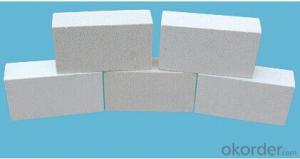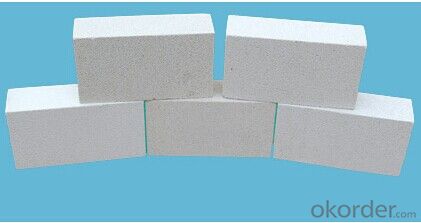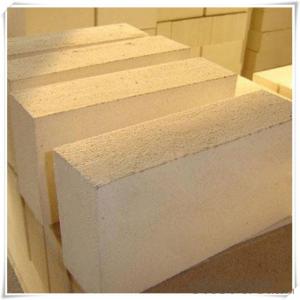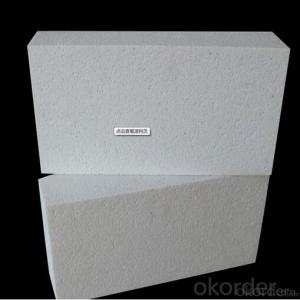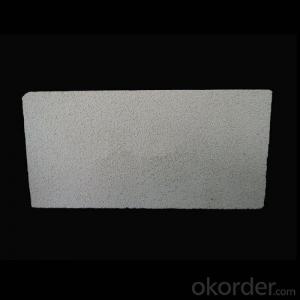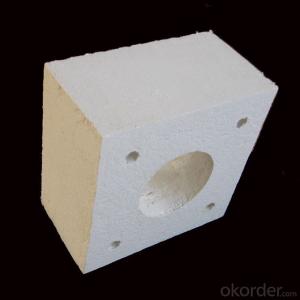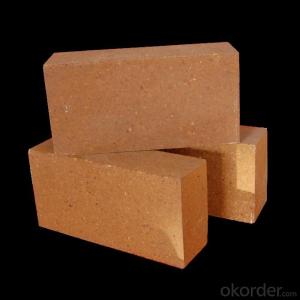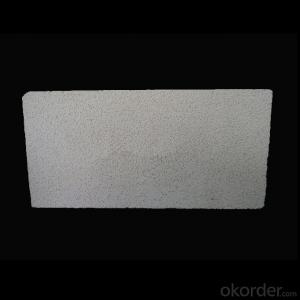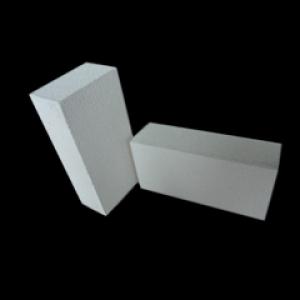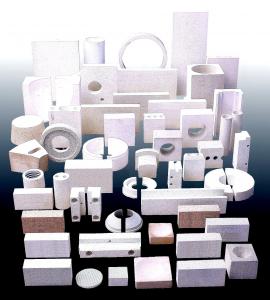Insulating Fire Brick with Anti-Permeability Carbon
- Loading Port:
- China Main Port
- Payment Terms:
- TT OR LC
- Min Order Qty:
- -
- Supply Capability:
- -
OKorder Service Pledge
OKorder Financial Service
You Might Also Like
Magnesia Carbon brick is resin-bonded brick made from dead-burned or fused magnesia and graphite. Anti-oxidant is added if required. Magnesia Carbon brick has good performance in thermal resistance, corrosion resistance and spalling resistance. Widely used in converters, EAFs, ladles and refining furnaces.
Magnesia Carbon brickis a very mature product in our area. As our area has 1/4 world storage of best quality Magnesia ore, we can provide as good quality as European Mg-C bricks with competitive prices. We also provide basic refracotry lining solution for CONVERTER, EAF, LF, LADLE, etc. these industrial furnaces.
The following are typial properties as per Chinese latest version standard. We also provide customer-tailored products as per customer special reuirements.
Specification
Sl. No. | MT10A | MT10B | MT10C | MT14A | MT14B | MT14C | MT18A | MT18B | MT18C |
A.P. % | 2 | 3 | 4 | 2 | 3 | 4 | 1 | 2 | 3 |
B.D. g/cm3 | 3.04 | 2.97 | 2.93 | 2.99 | 2.94 | 2.90 | 2.95 | 2.91 | 2.88 |
CCS MPa | 40.2 | 34.8 | 29.8 | 35.6 | 30.5 | 26.7 | 32.8 | 27.3 | 25.3 |
Bending strength mpa 1400×30min | 11.8 | 9.6 | 8.2 | 13.4 | 11.90 | 8.8 | 13.8 | 11.4 | 9.3 |
MgO % | 81.34 | 80.10 | 78.73 | 78.16 | 76.53 | 75.24 | 73.68 | 71.99 | 70.56 |
C % | 11.43 | 11.72 | 11.18 | 15.90 | 15.65 | 15.87 | 19.82 | 19.76 | 19.41 |
SiO2 % | 0.91 | 0.97 | 1.04 | 0.98 | 0.96 | 1.05 | 0.99 | 0.96 | 1.08 |
Fe2O3 % | 0.43 | 0.48 | 1.56 | 0.42 | 0.47 | 1.57 | 0.41 | 0.47 | 1.60 |
CaO % | 1.25 | 1.24 | 1.38 | 1.24 | 1.25 | 1.37 | 1.26 | 1.25 | 1.36 |
Fused megnesia specification.
BRAND | CHEMICAL PROPERTY % | B.D. OF GRAIN > g/cm3 | ||||
MgO > | SiO2< | CaO< | Fe2O3< | Al2O3< | ||
FM990 | 99.0 | 0.3 | 0.8 | 0.3 | 0.2 | 3.50 |
FM985 | 98.5 | 0.4 | 1.0 | 0.4 | 0.2 | 3.50 |
FM980 | 98.0 | 0.6 | 1.2 | 0.6 | 0.2 | 3.50 |
FM975 | 97.5 | 1.0 | 1.4 | 0.7 | 0.2 | 3.45 |
FM970 | 97.0 | 1.5 | 1.5 | 0.8 | 0.3 | 3.45 |
FM960 | 96.0 | 2.2 | 2.0 | 0.9 | 0.3 | 3.35 |
- Q: Are insulating fire bricks suitable for use in kilns?
- Indeed, kilns can benefit greatly from the utilization of insulating fire bricks. These bricks have been specifically engineered to endure high temperatures and possess exceptional insulation properties. Crafted from lightweight materials with low thermal conductivity, they possess the ability to efficiently retain heat and minimize heat loss. Consequently, they serve as an ideal lining for kilns, as they aid in the maintenance of consistent and controlled temperatures. This not only enhances energy efficiency but also reduces fuel consumption. Furthermore, insulating fire bricks exhibit remarkable resistance to thermal shock, enabling them to withstand sudden and extreme temperature fluctuations without succumbing to cracks or breakages. All in all, the utilization of insulating fire bricks for kiln linings guarantees reliability, effectiveness, and the elongation of the kiln's lifespan.
- Q: What is the recommended thickness for insulating fire brick installations?
- The recommended thickness for insulating fire brick installations typically ranges from 2 to 4 inches.
- Q: What industries commonly use insulating fire bricks?
- Insulating fire bricks find widespread use in diverse industries that require high-temperature insulation. Some of the sectors that commonly utilize these bricks are: 1. Steel industry: Furnaces, kilns, and other equipment in steel manufacturing plants are lined with insulating fire bricks to enhance insulation, minimize heat loss, and optimize energy efficiency. 2. Glass industry: Insulating fire bricks are employed in furnaces and ovens where glass is melted and molded. They maintain high temperatures, minimize heat loss, and ensure consistent and efficient production. 3. Ceramic industry: Ceramic kilns and pottery ovens rely on insulating fire bricks for thermal insulation, which helps maintain the desired temperature for clay and ceramic products. These bricks conserve energy and optimize firing processes. 4. Cement industry: Cement kilns require efficient high-temperature insulation, achieved through the use of insulating fire bricks. They line the kilns, reducing heat loss and improving thermal efficiency. 5. Foundry industry: Foundries use insulating fire bricks to line melting furnaces and ovens for metal casting. These bricks retain heat, ensuring consistent and efficient metal melting. 6. Power generation industry: Boilers, furnaces, and incinerators in power plants benefit from the thermal insulation provided by insulating fire bricks. They prevent heat loss, improving overall power generation efficiency. 7. Petrochemical industry: Refineries and chemical processing plants rely on insulating fire bricks to line reactors, furnaces, and ovens. These bricks offer insulation against high temperatures and harsh chemical environments. 8. Pharmaceutical industry: Insulating fire bricks are used in pharmaceutical manufacturing facilities to line ovens and dryers. They enable precise temperature control and enhance energy efficiency. In conclusion, insulating fire bricks have wide-ranging applications in industries that emphasize the importance of high-temperature insulation for efficient and cost-effective operations.
- Q: Are insulating fire bricks resistant to thermal bridging?
- Insulating fire bricks possess resistance against thermal bridging. Thermal bridging arises when a material allows heat to flow directly, thereby bypassing the insulation. Insulating fire bricks counteract this issue by minimizing thermal conductivity, which renders them ineffective at conducting heat. This characteristic aids in maintaining a uniform temperature on either side of the brick, thereby preventing thermal bridging and enhancing the overall insulation performance.
- Q: Do insulating fire bricks have a high thermal shock resistance?
- Insulating fire bricks are commonly known for their remarkable thermal shock resistance. They are specifically engineered to endure sudden temperature variations without any fractures or damage. Crafted from lightweight refractory materials with low thermal conductivity, these bricks effectively reduce heat transfer and prevent thermal strain. Furthermore, the firing process they undergo further enhances their ability to withstand thermal shocks. In summary, these bricks are perfect for situations where extreme temperature fluctuations are encountered, making them a dependable option for insulation in high-temperature surroundings.
- Q: Are insulating fire bricks resistant to cracking under pressure?
- Insulating fire bricks exhibit resistance to cracking when subjected to pressure. They are specifically engineered to endure elevated temperatures and mechanical strain. Composed of lightweight materials with low thermal conductivity, like ceramic fiber or lightweight aggregates, these bricks maintain their structural integrity even under pressure or thermal expansion. Moreover, insulating fire bricks typically possess a significant alumina content, enhancing their strength and crack resistance. These qualities make them an excellent choice for applications requiring insulation and structural stability, such as furnaces, kilns, and high-temperature industrial processes. Nevertheless, it is crucial to acknowledge that excessive pressure or abrupt temperature changes can still harm insulating fire bricks. Thus, it is essential to adhere to proper installation and maintenance guidelines to ensure their durability and performance.
- Q: Is it necessary to use mortar when installing insulating fire bricks?
- Yes, it is necessary to use mortar when installing insulating fire bricks. Mortar is a crucial component in the installation process as it helps to bond the bricks together, ensuring a tight and secure fit. It also helps to create a strong and durable structure that can withstand high temperatures. Without mortar, the bricks may not be properly secured and could shift or become loose, compromising the integrity of the installation. Additionally, mortar helps to fill in any gaps or spaces between the bricks, providing insulation and preventing heat loss. Therefore, using mortar is essential for a successful and effective installation of insulating fire bricks.
- Q: Can insulating fire bricks be cut or shaped using common tools?
- Indeed, common tools can be utilized to cut or mold insulating fire bricks. These bricks are typically composed of lightweight refractory substances like clay and minerals, making them more amenable to cutting and shaping than conventional fire bricks. To achieve the desired dimensions and design, one can employ basic tools such as a handsaw, angle grinder, or even a chisel and hammer. However, it is crucial to prioritize safety when handling insulating fire bricks by donning protective gear like gloves, goggles, and a dust mask. This precautionary measure is necessary to avert any potential health risks.
- Q: Can insulating fire bricks be used in hydrogen furnaces?
- Insulating fire bricks possess the capability to be utilized in hydrogen furnaces, although it is imperative to acknowledge that not all variants of insulating fire bricks are suitable for this particular purpose. Due to the highly reactive nature of hydrogen gas, certain materials can deteriorate or react, thereby giving rise to concerns regarding safety and potential harm to the furnace. When making a selection of insulating fire bricks for employment in hydrogen furnaces, it becomes crucial to opt for bricks that are explicitly designed for environments characterized by high temperatures and corrosive conditions. These bricks ought to be constructed from materials that exhibit resistance against hydrogen embrittlement and possess a low reactivity with hydrogen. Silicon carbide (SiC) and alumina-silica (Al2O3-SiO2) are frequently utilized materials for insulating fire bricks within hydrogen furnaces. These materials boast remarkable resistance to elevated temperatures and remain chemically stable when exposed to hydrogen. Moreover, it is of utmost importance to take into account the density and porosity of the insulating fire bricks. For hydrogen furnaces, it is preferable to employ bricks with low density and high porosity, as they offer enhanced thermal insulation and diminish the likelihood of hydrogen leakage. In conclusion, while insulating fire bricks can be employed in hydrogen furnaces, it is crucial to meticulously select the appropriate type of bricks that are specifically engineered for high-temperature and corrosive environments, and exhibit commendable resistance against hydrogen embrittlement and reactivity. Seeking consultation from specialists in the field and adhering to the guidelines provided by the manufacturer is highly recommended to ensure the safe and efficient operation of the hydrogen furnace.
- Q: What is the recommended method for installing insulating fire bricks?
- The recommended method for installing insulating fire bricks is to first prepare the surface by cleaning it thoroughly and ensuring it is dry. Then, apply a thin layer of refractory mortar to the surface where the bricks will be placed. Carefully lay the bricks in a tight, staggered pattern, pressing them firmly into the mortar. Use a level to ensure they are properly aligned. Allow the mortar to dry completely before subjecting the bricks to heat.
Send your message to us
Insulating Fire Brick with Anti-Permeability Carbon
- Loading Port:
- China Main Port
- Payment Terms:
- TT OR LC
- Min Order Qty:
- -
- Supply Capability:
- -
OKorder Service Pledge
OKorder Financial Service
Similar products
Hot products
Hot Searches
Related keywords
